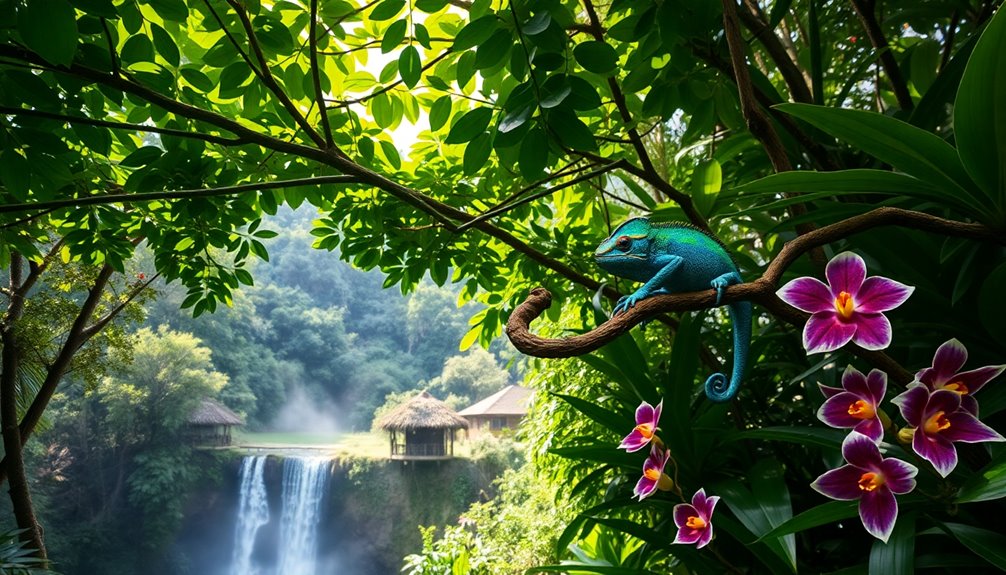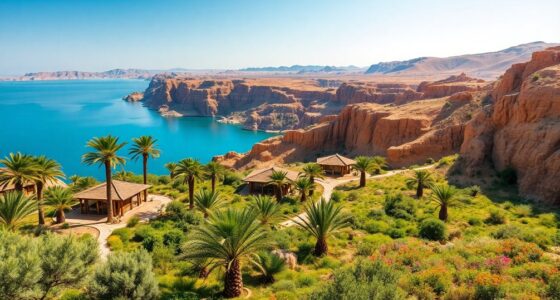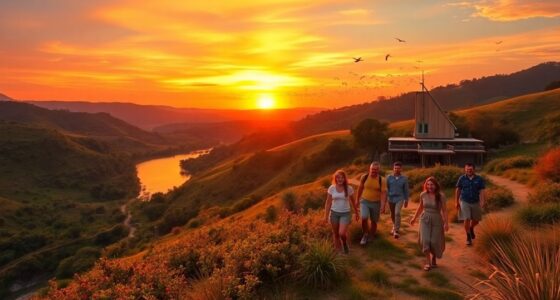Madagascar's green side is a treasure trove of unique biodiversity and eco-tourism opportunities. With around 90% of its wildlife being endemic, you'll encounter incredible species like lemurs and chameleons. Explore diverse ecosystems ranging from lush rainforests to vibrant coral reefs. By engaging in responsible eco-tourism, you can support local communities and conservation projects while enjoying activities like hiking and wildlife watching. Opt for sustainable transportation options and stay in eco-friendly lodges to minimize your footprint. You'll find that embracing Madagascar's natural beauty also enhances your travel experience, revealing even more about this extraordinary island.
Key Takeaways
- Madagascar is home to over 200,000 species, with 90% being endemic, highlighting its exceptional biodiversity and unique ecosystems.
- Eco-tourism in Madagascar promotes sustainable travel, benefiting local economies and funding conservation efforts through activities like hiking and wildlife watching.
- National parks, such as Andasibe-Mantadia, offer immersive eco-friendly experiences while protecting unique species and habitats.
- Community engagement is crucial for conservation, with local participation in reforestation and sustainable land management practices.
- Visitors can explore Madagascar using eco-friendly transportation options, including rental bicycles, electric vehicles, and cultural tuk-tuk rides.
Introduction
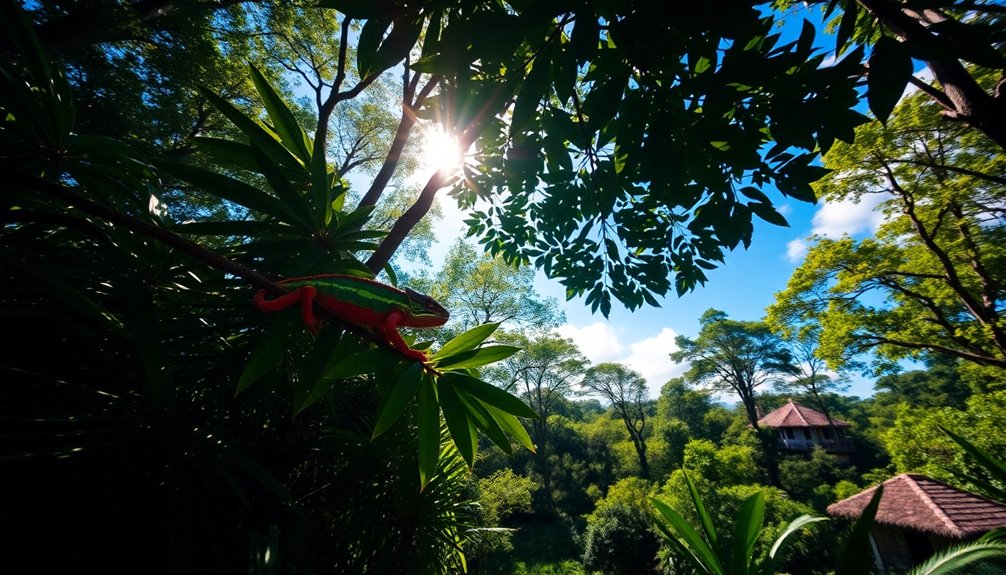
When you think about Madagascar, you can't ignore its rich cultural heritage and the incredible ecosystems that define the island.
These unique environments not only support diverse wildlife but also reflect the traditions and practices of its people.
Rich Cultural Heritage
Madagascar's rich cultural heritage captivates visitors with its vibrant tapestry woven from over 18 distinct ethnic groups. Each group offers unique cultural practices and traditions, enhancing the island's allure.
You'll find traditional festivals like the Famadihana, where families honor their ancestors, showcasing deep respect for community and heritage.
As you explore, be sure to admire the exquisite craftsmanship, from intricate wood carvings to beautifully woven textiles, often available in local markets.
Don't miss tasting unique dishes such as Romazava, a savory meat stew, which highlights Madagascar's rich culinary tradition.
The island's oral traditions and storytelling also play a vital role, preserving folktales and legends that keep the spirit of its diverse cultures alive for generations to come.
Preserving Madagascar's Unique Ecosystems
Exploring Madagascar's rich cultural heritage naturally leads to an appreciation of its extraordinary ecosystems.
With about 90% of its wildlife being endemic, the island boasts remarkable biodiversity, including unique species like lemurs and chameleons.
However, deforestation and habitat loss threaten these fragile ecosystems, as over 90% of original forest cover has vanished.
Conservation efforts are critical to protect Madagascar's unique ecosystems. Engaging local communities in sustainable tourism initiatives not only generates income but also encourages stewardship of natural resources.
By integrating local knowledge into these collaborative conservation efforts, you can help ensure the effective protection and restoration of Madagascar's exceptional environment.
Together, we can preserve this irreplaceable treasure for future generations.
Travel From Antananarivo Airport
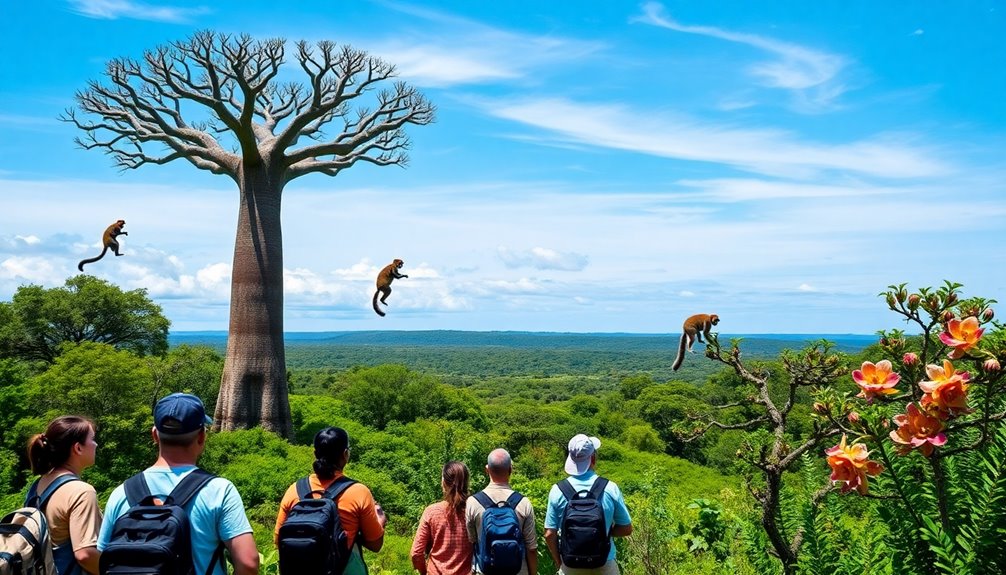
When you land at Antananarivo Airport, you've got several options for getting here, whether you're flying in from the USA, Paris, or Sydney.
Once you're in the capital, consider hopping on a tuk-tuk for a fun and local way to explore the city.
This airport serves as your gateway to Madagascar's incredible eco-tourism experiences.
Flights From USA to Antananarivo
If you're planning a trip to Madagascar, you'll likely find yourself landing at Antananarivo Airport, officially known as Ivato International Airport (TNR).
This airport serves as the primary gateway for international flights, connecting you from various cities in the USA. Major airlines like Air France, Ethiopian Airlines, and Turkish Airlines offer connecting flights, usually with layovers in Paris, Addis Ababa, or Istanbul.
Expect flight durations from the East Coast to range between 18 to 24 hours, depending on layover times. Before you go, check visa requirements and consider applying for a Madagascar eVisa online.
Once you arrive, Antananarivo is just 15 kilometers from downtown, setting you up perfectly for eco-tourism adventures and exploring Madagascar's unique biodiversity.
Flights From Paris to Antananarivo
How can you make your journey from Paris to Antananarivo seamless? Start by booking your flights from Charles de Gaulle Airport (CDG).
Direct flights with Air France and Tsaradia take about 10 to 12 hours, while other options may include stopovers in cities like Nairobi or Addis Ababa. Round-trip fares typically range from €600 to €1,200, so plan ahead for the best deals.
Aim to travel during the dry season, from April to October, when Madagascar's unique biodiversity is most accessible and the ecotourism activities are at their peak.
Once you arrive at Antananarivo Airport (Ivato International Airport), you'll be ready to explore the sustainable wonders of Madagascar and contribute to its thriving ecotourism scene.
Flights From Sydney to Antananarivo
Wondering about the best way to get from Sydney to Antananarivo? You'll find that flights typically require at least one layover, often in cities like Bangkok, Johannesburg, or Dubai. The journey can take between 22 to 30 hours, so plan accordingly. Antananarivo Airport, also known as Ivato International Airport, is Madagascar's main gateway and offers various services for travelers interested in exploring this biodiversity hotspot and engaging in eco-tourism and conservation efforts.
| Airline | Layover City | Flight Duration (Approx.) |
|---|---|---|
| Air France | Johannesburg | 24-28 hours |
| Qatar Airways | Bangkok | 25-30 hours |
| Ethiopian Airlines | Addis Ababa | 22-26 hours |
| Emirates | Dubai | 25-29 hours |
| South African Airways | Johannesburg | 24-27 hours |
Don't forget to check visa requirements before booking!
Tuk-Tuk Rides in Antananarivo
After landing at Antananarivo Airport, hopping on a tuk-tuk, or "taxi-be," is a fantastic way to start your adventure in Madagascar's capital.
These colorful tuk-tuks aren't only affordable, with rides costing between 1,000 and 5,000 Malagasy Ariary, but also provide a unique glimpse into local life.
As you travel, you'll engage with local communities, fostering cultural exchange and social interaction. The ride to the city center takes about 30 to 45 minutes, offering scenic views that highlight both the beauty of the landscape and the importance of wildlife conservation.
Sustainable Wildlife Tours
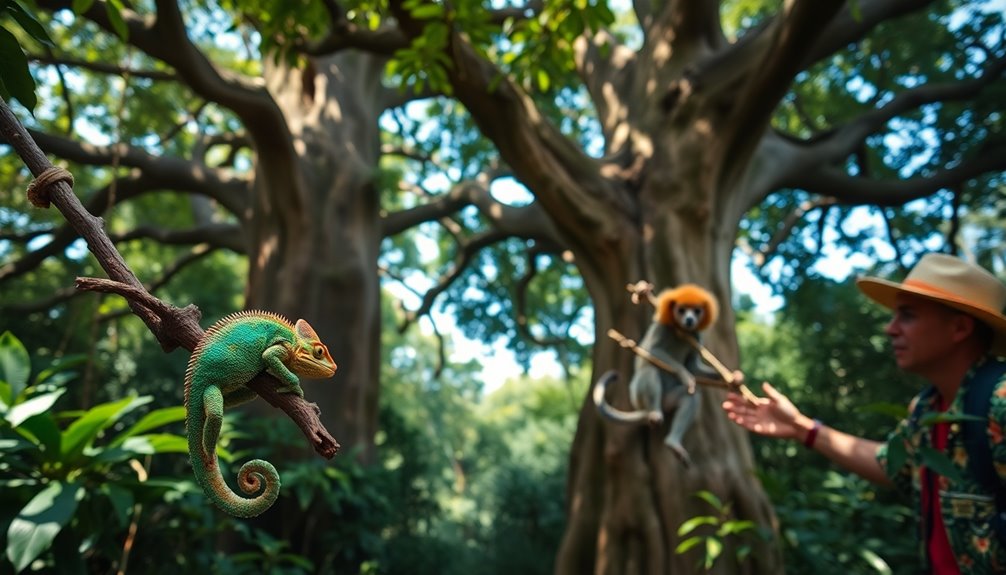
When you choose sustainable wildlife tours in Madagascar, you're not just observing unique species; you're actively contributing to their protection.
Eco-friendly wildlife encounters and guided nature walks provide you with immersive experiences while minimizing your impact on the environment.
Plus, with solar-powered lodging options, you can rest easy knowing your stay supports both local communities and conservation efforts.
Eco-Friendly Wildlife Encounters
As you embark on eco-friendly wildlife encounters in Madagascar, you'll discover a world where responsible tourism meets breathtaking biodiversity.
These sustainable wildlife tours prioritize respectful interactions with the island's unique fauna, including over 100 endemic lemur species. You'll engage in enriching experiences that contribute to wildlife conservation and local economies.
Expect to enjoy:
- Strict guidelines ensuring safe distances from wildlife
- Educational components highlighting Madagascar's rich biodiversity
- Opportunities to support local guides and artisans
- Direct contributions to conservation projects and sustainable development
Eco-Conscious Guided Nature Walks
Eco-conscious guided nature walks in Madagascar offer a remarkable way to explore the island's stunning landscapes while prioritizing environmental stewardship.
These sustainable wildlife tours focus on minimizing environmental impact, adhering to strict wildlife observation guidelines to protect endemic species like lemurs and chameleons.
You'll often walk alongside local guides who share their insightful knowledge about Madagascar's unique ecosystems, enriching your experience and supporting local communities.
Many guided tours promote conservation awareness, educating you on biodiversity challenges such as habitat loss and climate change.
Plus, you can actively participate in reforestation projects or habitat restoration initiatives, making a positive impact during your visit.
Solar-Powered Lodging Options
Staying at solar-powered lodges in Madagascar not only enhances your travel experience but also aligns it with sustainable practices that protect the island's remarkable biodiversity.
By choosing eco-friendly accommodations like Anjajavy LHotel, you can enjoy a guilt-free getaway while contributing to the local economy and conservation efforts.
Here's what you can expect:
- Renewable energy use to minimize environmental impact
- Unique wildlife tours guided by local experts
- Employment opportunities for the community
- Support for the preservation of Madagascar's endemic species
Your stay at these solar-powered lodges helps reduce your carbon footprint, ensuring that your adventure respects the local ecosystems.
Plus, you'll be part of vital conservation efforts that benefit the island's unique wildlife.
Eco-Friendly Transportation Options
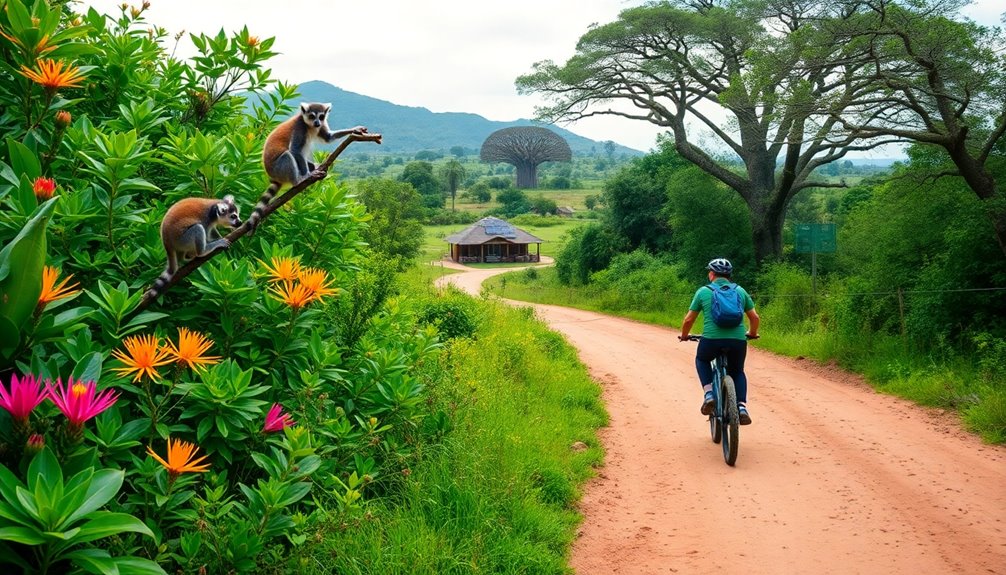
When you explore Madagascar, you'll find an array of eco-friendly transportation options that make it easy to travel sustainably.
Consider renting a bicycle in urban areas or national parks, allowing you to minimize your carbon footprint while enjoying the scenery. Many eco-lodges and tour operators offer electric or hybrid vehicles for guided tours, significantly cutting greenhouse gas emissions.
Using local public transport, like "taxi-brousse" (shared minibuses), not only supports community economies but also promotes sustainable travel by reducing private vehicle use.
In regions like Nosy Be, you can even take electric boat tours for marine exploration.
Lastly, hiking in protected areas like Andasibe-Mantadia National Park fosters a closer connection with nature while keeping your impact on the environment low.
Community-Led Reforestation Projects
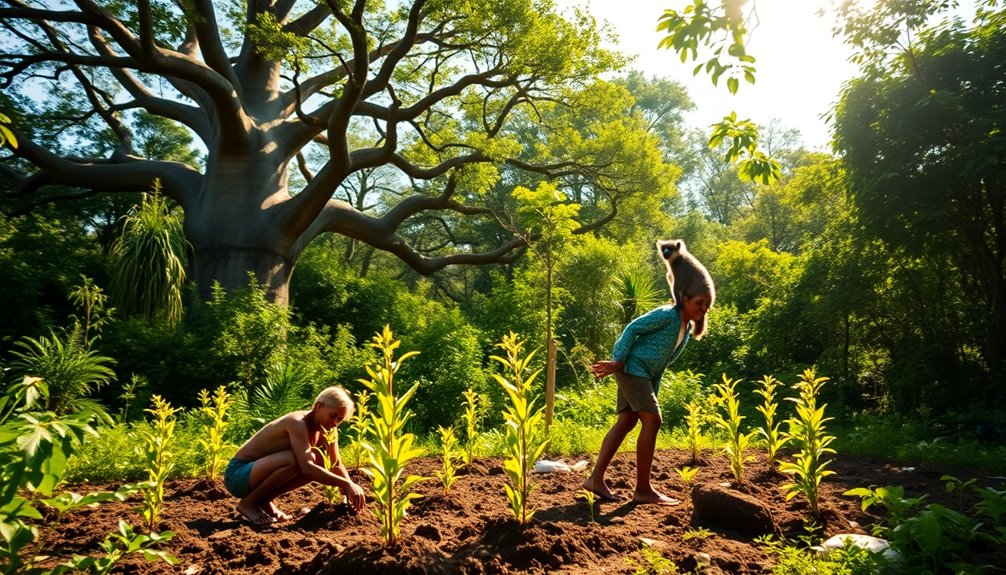
Community-led reforestation projects in Madagascar are making a real impact on both the environment and local livelihoods.
By working together with NGOs and the government, you can help restore native forests and enhance cultural sustainability.
These efforts not only provide jobs but also ensure future generations appreciate the island's incredible biodiversity.
Government and NGO Efforts
While Madagascar faces significant challenges due to deforestation, innovative community-led reforestation projects are making a difference by restoring degraded landscapes and enhancing local livelihoods.
These initiatives focus on empowering local communities through sustainable land management practices.
Consider these key aspects:
- Biodiversity Monitoring: Regular assessments to track ecosystem health.
- Native Tree Planting: Collaboration with organizations like the Madagascar Biodiversity Partnership.
- Training in Agroforestry: Skill development for better resource management.
- Community Involvement: Ensuring local populations play a crucial role in conservation strategies.
Since the early 2000s, over 25 million trees have been planted, significantly contributing to the restoration of vital ecosystems while fostering economic stability and ecological health in Madagascar.
Community and Cultural Sustainability
As Madagascar grapples with severe deforestation, local communities are stepping up to reclaim their landscapes through innovative reforestation projects.
These community-led initiatives not only combat deforestation but also enhance the well-being of local communities. By integrating traditional knowledge into restoration strategies, you're helping to plant thousands of native trees, boosting biodiversity and providing habitats for endangered species like lemurs.
Engaging in these projects fosters community ownership, creating sustainable livelihoods through jobs in forest management and ecotourism.
Moreover, as diverse ecosystems flourish, food security improves for local populations, ensuring access to essential resources.
This holistic approach preserves cultural heritage while promoting a healthier environment, making Madagascar's green future brighter for generations to come.
Optimal Months for Eco-Travel
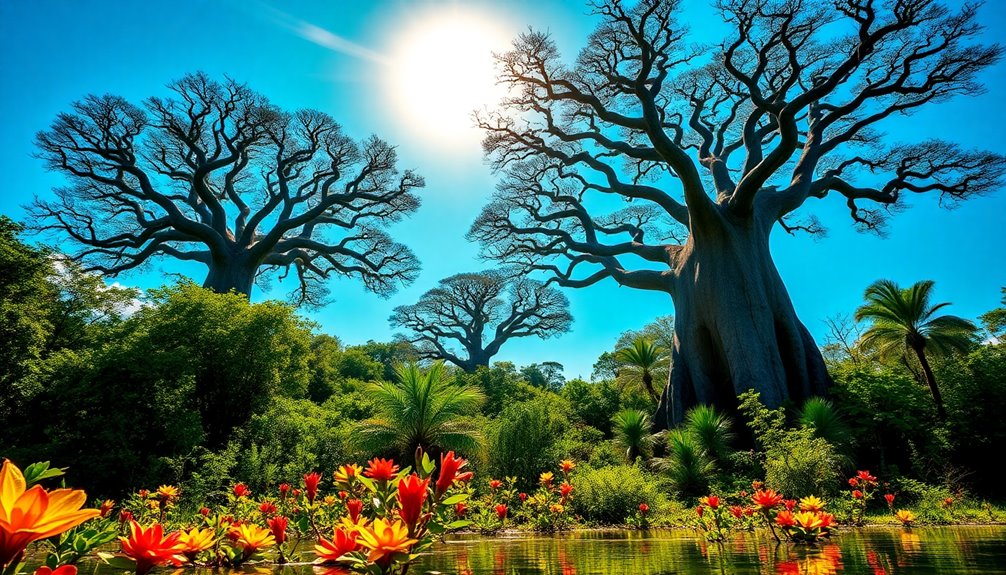
If you want to experience Madagascar's incredible wildlife, plan your trip between April and October during the dry season.
This is when you'll have the best chance to spot unique species, especially lemurs, while avoiding the tropical cyclone season.
Keep in mind that the peak months of July and August can get crowded, so consider visiting in the shoulder months for a more peaceful adventure.
Best Months for Nature Spotting
To experience Madagascar's incredible biodiversity, plan your visit during the dry season from April to October.
These months are the best for nature spotting, offering optimal conditions for wildlife viewing, especially unique primates like lemurs.
Here's what you can expect:
- April: Increased lemur activity post-birthing season.
- May to August: Cooler, drier weather perfect for exploring rainforests and national parks.
- September and October: Great for spotting migratory birds with less dense vegetation.
- Wildlife Festivals: Engage with local communities for an enhanced eco-travel experience.
Tropical Cyclone Season Awareness
While Madagascar's stunning landscapes and diverse wildlife draw many eco-travelers, it's crucial to be aware of the tropical cyclone season, which runs from November to April.
The highest frequency of storms occurs between January and March, making these months less ideal for your eco-travel plans. Cyclones can cause severe flooding and damage, impacting both wildlife and local communities.
To enhance your experience, consider visiting during the dry season from April to October, when the weather is stable and perfect for witnessing Madagascar's unique biodiversity.
Always monitor weather forecasts and heed cyclone warnings to ensure safety. By traveling during the dry season, you'll also support sustainable tourism, benefiting local economies that thrive on eco-friendly visitors.
How to Make Your Trip More Sustainable
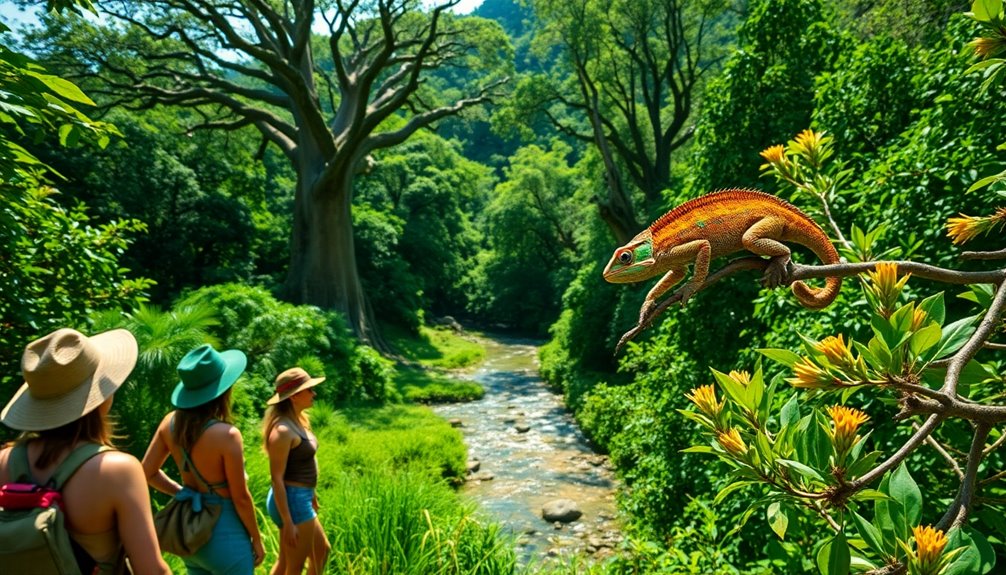
When planning your trip to Madagascar, consider using biodegradable toiletries and containers to reduce waste.
Opting for locally sourced food not only supports the economy but also minimizes your carbon footprint.
These simple choices can make a big difference in promoting sustainable tourism.
Biodegradable Toiletries and Containers
Sustainable travel in Madagascar hinges on your choices, especially regarding toiletries and containers. By opting for biodegradable toiletries and compostable containers, you can significantly reduce plastic waste and support biodiversity conservation.
Here are some tips to make your trip more eco-friendly:
- Choose shampoo bars and soap sheets to minimize plastic use.
- Use compostable containers for food and personal items.
- Bring reusable toiletry containers to reduce waste.
- Support local economies by purchasing from eco-friendly businesses.
These actions not only lessen your environmental impact but also help protect Madagascar's unique ecosystems and endemic species, like lemurs.
Plus, participating in programs that promote biodegradable products fosters awareness and appreciation for the incredible biodiversity that the island has to offer.
Locally Sourced Food Choices
How can you make a positive impact on Madagascar's environment during your visit?
By choosing locally sourced food, you not only enhance your culinary experience but also support local farmers and promote sustainable livelihoods. Madagascar boasts unique agricultural products like vanilla, coffee, and cocoa that you should definitely try.
Eating fresh, seasonal produce from local markets reduces your carbon footprint, making your meals environmentally friendly. Opting for traditional Malagasy dishes made from locally sourced ingredients helps preserve cultural heritage and encourages sustainable practices within the community. Additionally, incorporating nutrient-rich foods like chia seeds into your diet can enhance your overall health and well-being while you explore Madagascar.
Frequently Asked Questions
What Is Unique About the Biodiversity in Madagascar?
Madagascar's biodiversity is truly remarkable.
You'll find that around 90% of its wildlife is unique to the island, including over 100 species of lemurs.
The flora is just as impressive, with about 11,516 native vascular plant species, 82% of which are endemic.
Plus, roughly 80% of the world's chameleon species live exclusively here.
This isolation has fostered a fascinating array of species that you won't see anywhere else on Earth.
Does Madagascar Have Ecotourism?
Yes, Madagascar definitely has ecotourism!
You'll find that it emphasizes sustainable travel while showcasing the island's unique wildlife and stunning landscapes. By exploring places like Andasibe-Mantadia National Park or Tsingy de Bemaraha, you can enjoy diverse ecosystems and support local communities.
Engaging in responsible travel helps protect endangered species and preserves habitats, ensuring that future generations can also experience Madagascar's natural wonders.
What Makes Madagascar Unique?
You might think Madagascar's just another island, but it's anything but ordinary.
With around 90% of its wildlife found nowhere else, you'll encounter unique species like lemurs and chameleons that can't be seen elsewhere.
The island's rich ecosystems, from rainforests to dry forests, support a vast array of plants and animals, many of which are endemic.
This incredible biodiversity highlights Madagascar's significance as a vital part of our planet's ecological heritage.
What Is the Biodiversity of the Madagascar Rainforest?
When you explore Madagascar's rainforests, you'll discover an astonishing array of biodiversity.
With over 100 unique lemur species and around 90% of its plants and 85% of its animals found nowhere else, the island's ecosystems are truly remarkable.
You'll encounter vibrant amphibians like the Mantella frogs, showcasing the rainforest's diversity.
However, you should be aware that habitat loss poses a significant threat to these endemic species, making conservation efforts crucial.
Conclusion
As you explore Madagascar's lush landscapes and rich biodiversity, you'll realize that every step you take can contribute to its preservation. Imagine witnessing the vibrant wildlife while knowing your eco-friendly choices are making a difference. By supporting sustainable tours and local communities, you're not just a visitor; you're a guardian of this unique paradise. So, why not embark on a journey that benefits both you and the planet? Your adventure can help ensure Madagascar's green side thrives for generations to come.

